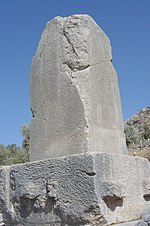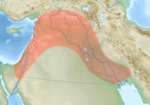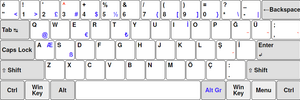Milyan, also known as Lycian B and previously Lycian 2, is an extinct ancient Anatolian language. It is attested from three inscriptions: two poems of... 19 KB (1,689 words) - 22:50, 8 April 2024 |
an unattested Semitic language (this opinion is not commonly supported), whereas the Milyan language was an Indo-European language. Later the name Milyas... 3 KB (471 words) - 00:01, 5 January 2024 |
 | (13th–8th century BC) Proto-Lyco-Carian Proto-Carian–Milyan Carian (7th–3rd century BC) Milyan (5th century BC) Proto-Lycian–Sidetic Lycian (5th–4th... 43 KB (4,764 words) - 00:29, 16 April 2024 |
 | Gyges of Lydia (category Articles containing Milyan-language text) "grandfather": Hittite ḫuḫḫa (𒄷𒄴𒄩), Luwian ḫūḫa- (𒄷𒌋𒄩) and huha- (𔕳𔓷), Milyan xuga- (𐊜𐊒𐊄𐊀), and Lycian xuga- (𐊜𐊒𐊄𐊀). If this etymology is accurate... 34 KB (3,974 words) - 23:31, 6 March 2024 |
Lycian (category Language and nationality disambiguation pages) lived in Lycia; extinct languages formerly spoken in Lycia, i.e. the Lycian language, also known as Lycian A and the Milyan language, formerly known as Lycian... 864 bytes (135 words) - 15:02, 13 July 2022 |
 | fifth and fourth century BC. Two languages are known as Lycian: regular Lycian or Lycian A, and Lycian B or Milyan. Lycian became extinct around the... 33 KB (2,605 words) - 22:57, 8 April 2024 |
 | Lycia (category Articles containing Turkish-language text) Milyas, and its original inhabitants, who spoke the Milyan language, were the Milyae (Μιλύαι), or Milyans, also known by the exonyms Sólymoi (Σόλυμοι), Solymi... 76 KB (8,703 words) - 01:23, 18 April 2024 |
ancient south-west Anatolia Milyan language, also known as Lycian B and previously Lycian 2, is an extinct ancient Anatolian language Milia, Famagusta, a village... 294 bytes (71 words) - 06:29, 1 September 2021 |
first to second centuries AD, it appears to be closely related to Lycian, Milyan, and Sidetic. Pisidian is known from about fifty funeral inscriptions, most... 8 KB (770 words) - 22:47, 8 April 2024 |
extinct language may be narrowly defined as a language with no native speakers and no descendant languages. Under this definition, a language becomes... 156 KB (4,688 words) - 08:27, 25 April 2024 |
 | Carians (category Articles containing Ancient Greek (to 1453)-language text) Carian language belongs to the Luwic group of the Anatolian family of languages. Other Luwic languages besides Luwian proper are Lycian and Milyan (Lycian... 23 KB (3,002 words) - 12:45, 6 April 2024 |
 | Antiphellus (category CS1 Turkish-language sources (tr)) in "Lycian B", now generally identified as Milyan, a Luwian language. Inscriptions in the Lycian language are dated from the 4th century BCE, as are the... 25 KB (2,685 words) - 13:16, 22 September 2023 |
 | Yosyf Milyan, MSU (also Romanized as Josyf Milan, Ukrainian: Йосиф Мілян; born 6 July 1956) is the titular bishop of Drusiliana and the auxiliary bishop... 3 KB (244 words) - 04:46, 27 February 2024 |
 | Kuldeep Manak (category Punjabi-language singers) Soorme (1978) including Banda Singh Bahadur Ghare chal kadun rarkan Dil milyan de mele Karo na yaar maar mitro Dil nahion lagda "Ghadney Jhande Khalsa... 13 KB (1,387 words) - 09:36, 19 April 2024 |
Indo-European vocabulary (category CS1 Polish-language sources (pl)) Studies. 38 (1–2): 26-27. Shevoroshkin, Vitaly. "Anatolian laryngeals in Milyan". In: The Sound of Indo-European: Phonetics, Phonemics, and Morphophonemics... 337 KB (8,973 words) - 19:43, 21 April 2024 |
 | Xanthian Obelisk (category CS1 German-language sources (de)) dynast standing on top. The three languages are Ancient Greek, Lycian and Milyan (the last two are Anatolian languages and were previously known as Lycian... 17 KB (2,314 words) - 23:17, 27 February 2024 |
 | Vitaly Shevoroshkin (category Articles containing Russian-language text) V. 2008. “Introduction to Milyan”. In: Mother Tongue XIII: 63—96. SHEVOROSHKIN, V.V. 2012. "Anatolian laryngeals in Milyan". In: The Sound of Indo-European:... 6 KB (710 words) - 18:44, 9 January 2023 |
 | Antalya Province (category CS1 Turkish-language sources (tr)) people called the Milyae (Milyans), who referred to the area as Milyas and spoke an Indo-European language known as Milyan. A people called the Termilae... 26 KB (2,563 words) - 21:12, 31 March 2024 |
 | Fertile Crescent (category Articles containing Arabic-language text) second, several language groups already existed in the region. These included: Proto-Euphratean language: a hypothetical non-Semitic language previously hypothesized... 32 KB (3,317 words) - 18:52, 24 April 2024 |
 | Xanthos (category Articles containing Turkish-language text) was found in the city; it records an older Anatolian language conventionally known as the Milyan. Xanthos is located near to the modern village of Kınık... 17 KB (1,571 words) - 19:59, 1 April 2024 |
 | Multilingual inscription (category CS1 French-language sources (fr)) Xanthos Obelisk (500 BCE; Xanthos, Turkey) in Ancient Greek, Lycian and Milyan the Van Fortress inscription (5th century BCE; Van, Turkey) in Old Persian... 13 KB (1,315 words) - 04:57, 22 April 2024 |








